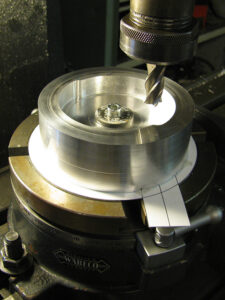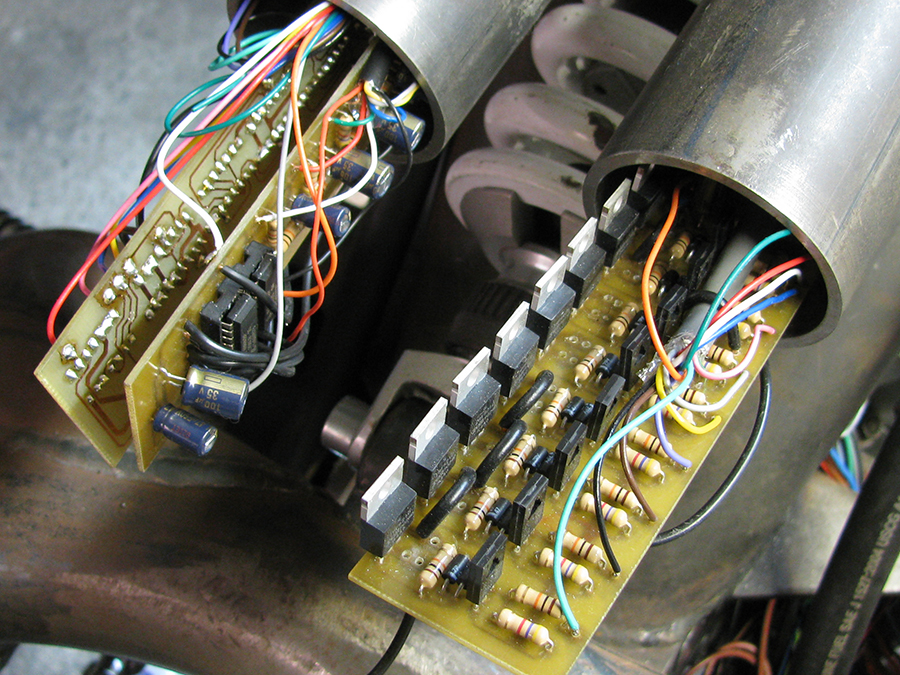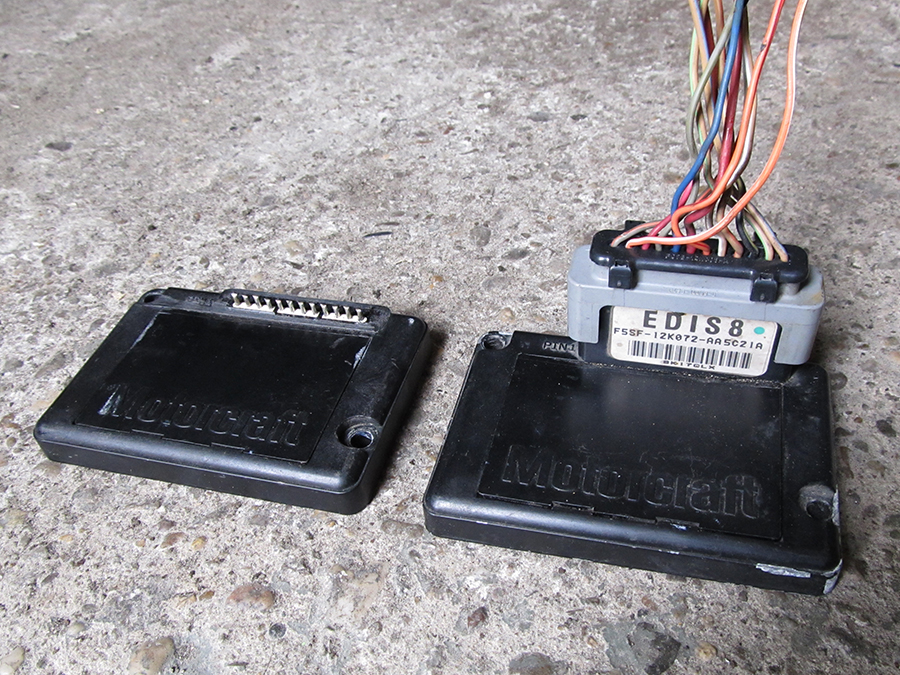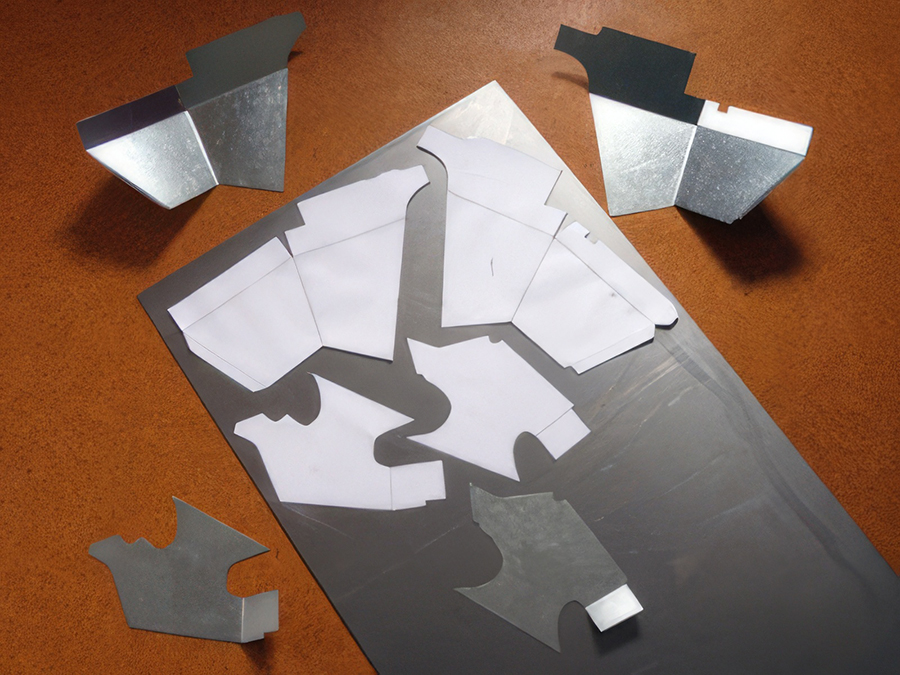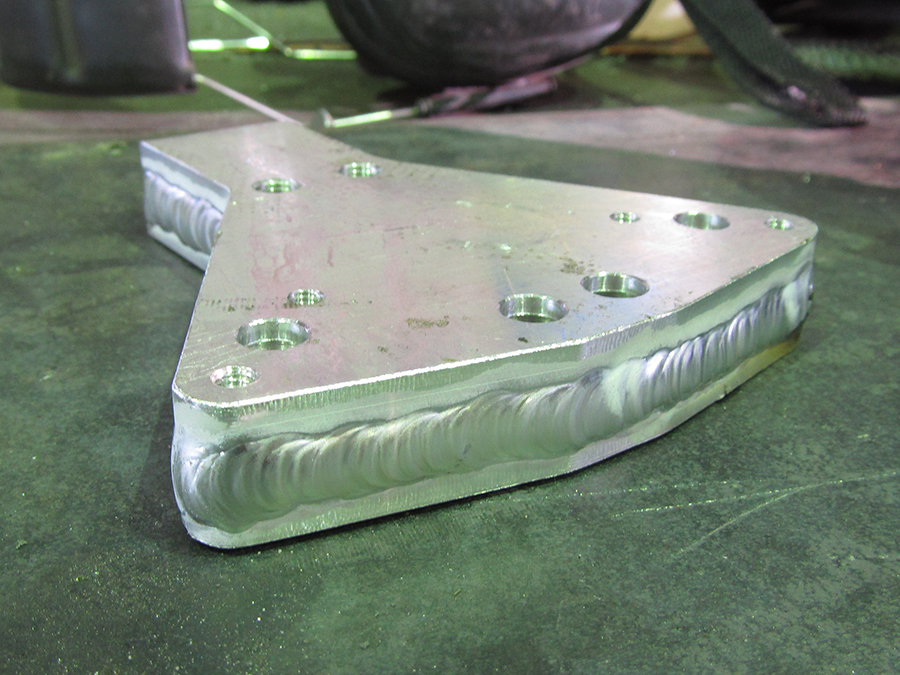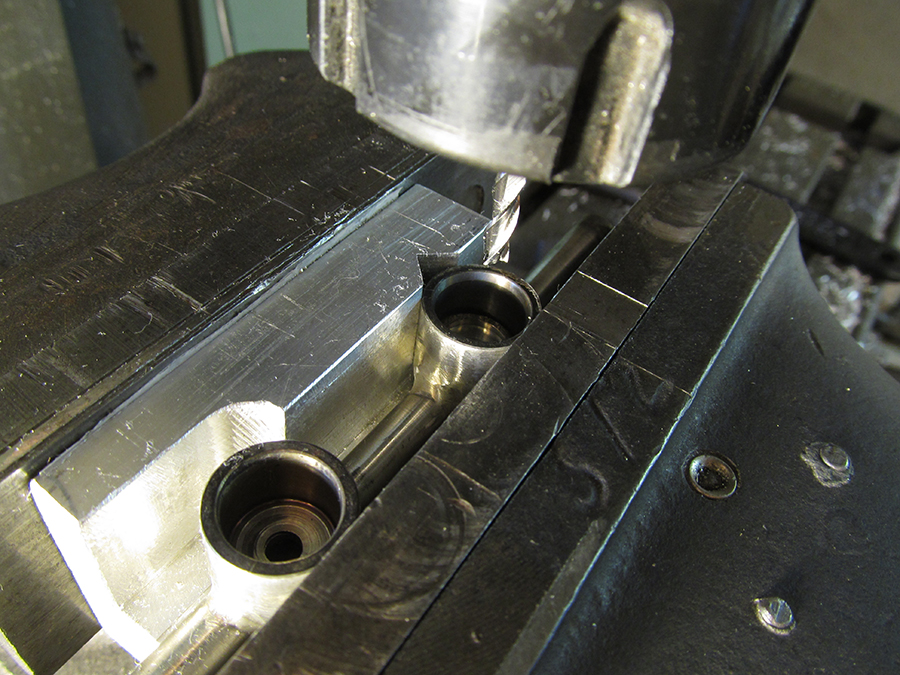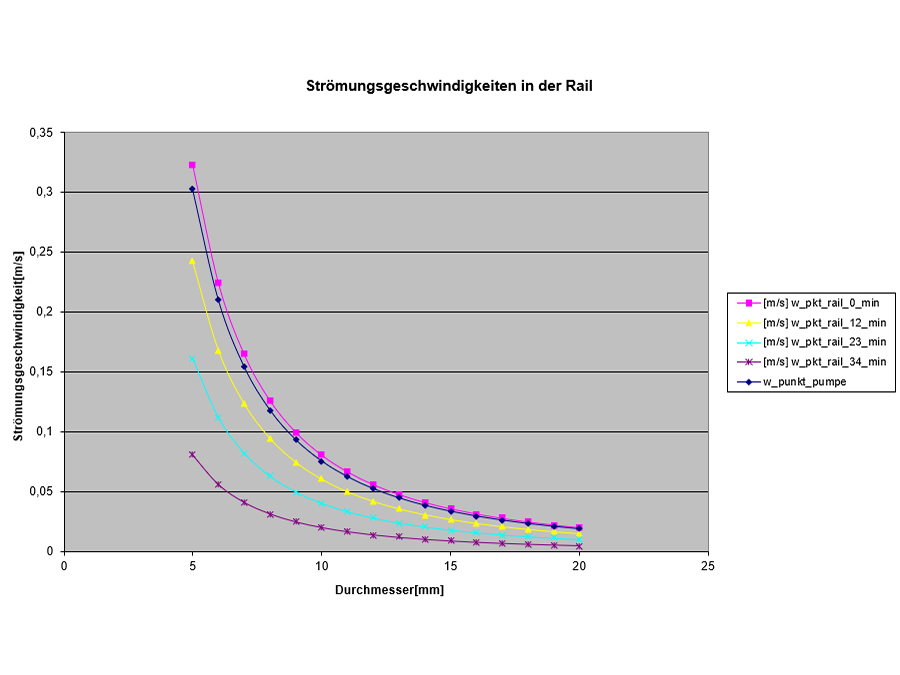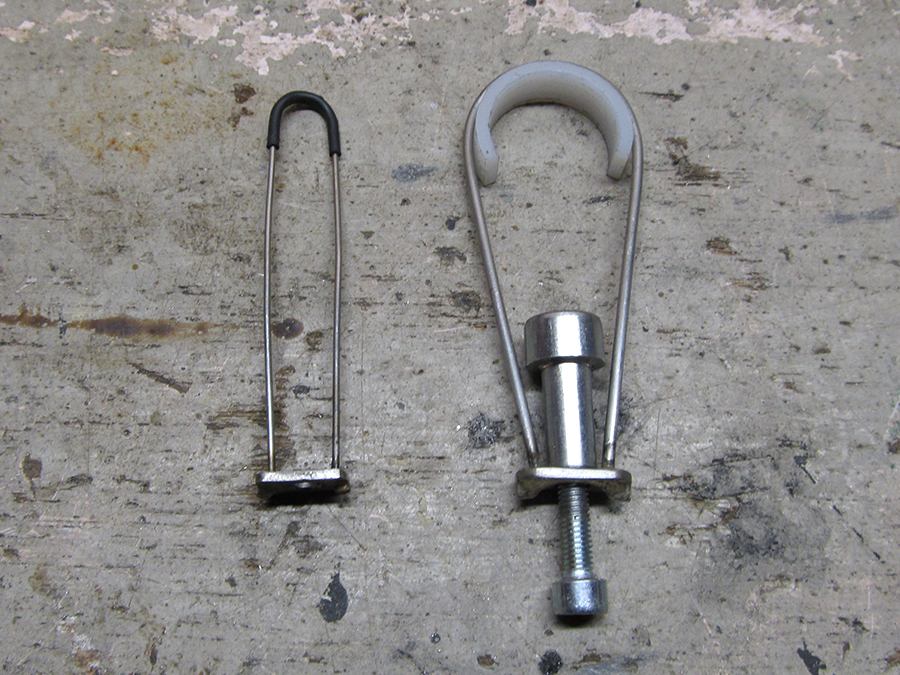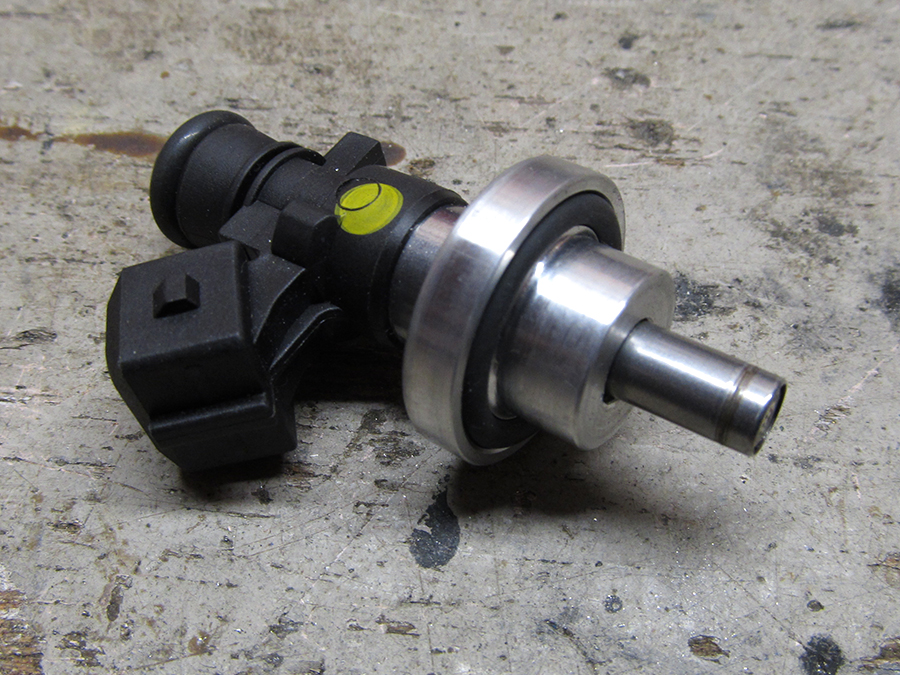Yes, September 5th 2010 was quite a euphoric day, it was the day the V8 bike proved to be rideable! So: just a paintjob away from finishing the project? Almost seventeen months later I can tell you this: no way.
 Because testing – and riding is just one of them – provided us with loads of data and a long to-do list. First of all: heat. Heat is one of the worst enemies in this project.
Because testing – and riding is just one of them – provided us with loads of data and a long to-do list. First of all: heat. Heat is one of the worst enemies in this project.
I started out making heat shealds for the seat pipes.
 Although quite rigid the front fork springs turned out to be not rigid enough. I put in the hardest springs on the market.
Although quite rigid the front fork springs turned out to be not rigid enough. I put in the hardest springs on the market.
You can ride a bike without a side stand if you never stop.
Klaus found me a chromoly steering axle from a VW Passat to use as a base.
The bike has two 40Amp alternators. It turned out that they should rev up earlier in order to nourish all the hungry current consumers. I drew a little scheme to determine the right diameter …
 Chris Jansen (owner of Hartgers Radiateuren) came to the workshop to test the bike’s coolant flow.
Chris Jansen (owner of Hartgers Radiateuren) came to the workshop to test the bike’s coolant flow.
 The pump’s entrance and exit design wasn’t optimal which reduced the flow and therefore the cooling capacity. So I designed a new one …
The pump’s entrance and exit design wasn’t optimal which reduced the flow and therefore the cooling capacity. So I designed a new one …
Niels was very busy the last months of 2010 so I took the opportunity to concentrate on some the bike’s details as well. For example the color scheme, and together with Mick Harmeling I designed the logo.
For lighting we need electronics. Together with Benno Krabbenborg I continued desiging and testing the one-off lighting electronics. Like in the CBX we used power transistors (the one on the right) in stead of ‘classical’ relays. They’re certainly smaller …
It fitted like a charm.
Unfortunately I found out that the engine would heat up the frame so much that the transistors might get overheated.
I took a deep breath and took the complete system out.
Damn.
 Benno found a nifty device called m-Unit which will take its place. I drew this scheme, installed all the wiring and … it worked.
Benno found a nifty device called m-Unit which will take its place. I drew this scheme, installed all the wiring and … it worked.
March 20th 2011: I got permission from the company Dekker van de Kamp to use their private roads (no snoops!) for testing the bike. Although it was a perfect sunny Sunday, the results were not that happy: the engine wasn’t running smooth at all so I had to heat up the clutch a lot while riding to prevent the bike from stalling.
On the left you see ‘newskool electronics’ Niels, on the right you see ‘oldskool experience’ Klaus. Behind Niels you see Frans, representing a very important skill: optimism.
Niels concluded that the cause of the problems might be unclean injectors. So I visited Peter Scheepers (owner of Scheepers Motorsport) in Germany. Peter built a special test rig for the injectors …
… and tested all sixteen of them. The amount of dirt was negligible which was good. And not good because it wasn’t the cause of the ill engine.
 Niels called in Gerhard Bekaan, an experienced engine tuner. He took with him some nice testing equipment …
Niels called in Gerhard Bekaan, an experienced engine tuner. He took with him some nice testing equipment …
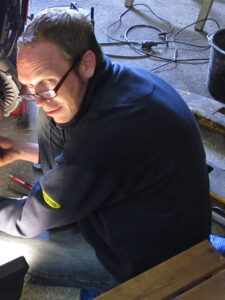 Tell us, Gerhard: were it the injection coils, the motor management, the spark plugs, the wiring, the injectors? The size of the fuel rails perhaps? Easy questions, difficult answers, even for pros.
Tell us, Gerhard: were it the injection coils, the motor management, the spark plugs, the wiring, the injectors? The size of the fuel rails perhaps? Easy questions, difficult answers, even for pros.
Gerhard wasn’t too keen on being photographed. Nor am I, actually. Still, here I am, connection the new ceramic spark plug boots …
Niels tested the MegaSquirt motormanagement system long and exhaustively. The newskool transistors which supply the ignition spark did not survive his torture …
… was amputated to save space. I love this kind of action because now this unit could be placed out of sight.
I disassembled the clutch because the EDIS module required the missing tooth of the triggerwheel to turn some degrees.
I disassembled the clutch because the EDIS module required the missing tooth of the triggerwheel to turn some degrees.
When I disassembled the clutch, I discovered that the so-called ‘pressure plate inserts’ were worn. Because they were not commercially available, I drew them and had them laser cut and leveled by the Goedhals company.
Could I affort the extra thickness? No: the small balancing weight under the nut just hit the frame.
The clutch needs a secure cover. I made the first version out of card board, then out of 0.7mm steel, and finally from 2mm steel. Erwin lent me his folding machine.
On July 3rd we had another testing day with Niels, Gerhard and Frans. It turned out to be the right choice to use the Ford EDIS 8 module because the sparks were significant more powerful than the sparks that MegaSquirt generated.
On the right you see a white heat resistant ceramic spark plug.
The ‘H’-word again: heat. During testing the fuel in the fuel rails (the tubes who feed the injectors) reached the critical temperature of 80 degrees Celsius which is about its boiling point. Cause: both pumps are at the start of the fuel system, the injectors are at the end (see picture). This means that there is no continuous fuel flow (= refreshment) in the fuel rails: the fuel only circulates between pumps, fuel pressure regulator and fuel tank. The fuel rails only get ‘fresh’ (read: colder) fuel when the engine consumes fuel e.g. is on. That is why the fuel rails heat up by the radiating engine.
Boiling fuel is no good. So I designed another system in which there is continous fuel circulation: both pumps push the fuel through all four fuel rails simultaniously, then pump the non-used fuel into the fuel pressure regulator and back into the tank. Even when the engine is off, the pumps can cool down the rails.
Quite some variations passed by. This one had the disadvantage that the four fuel rails weren’t ‘fed’ simultaniously. And I could never install a system like this …
… because all four fuel rails have to be disassembled individually due to the construction of the intake manifold.
Each ‘end cap’, as I call them, had to be made from two seperate parts, later welded together.
Gerhard pointed out that the inside diameter of the fuel rails might be too small for a powerful fuel-consumer like this. I tried to find a design in which they were bigger but wasn’t able to because there wouldn’t be enough space for the essential o-rings.
 I visited Ton van Soest, owner of de Locloods, several times to discuss how to make the o-ring grooves. He found the perfect cutting tool for my lathe.
I visited Ton van Soest, owner of de Locloods, several times to discuss how to make the o-ring grooves. He found the perfect cutting tool for my lathe.
Quite a challange to make such grooves on a traditional lathe: even the slightest error would break the tiny cutting tool, ruin the work or, even worse, eventually result in a leaking construction. And you don’t want spraying fuel on your hot engine and exhaust.
Again I used the four-claw chuck, this time with a counterweight to prevent the lathe from walking through my garage.
A very spectacular moment and yet not spectacular at all: putting 3,5 bar fuel pressure on the system and … nothing happens. No leak in any of the 45 (!) potential leaking points, which was great.
October 22th 2011: another sunny day and a perfect day to transport the bike to Scheepers Motorsport. That afternoon I managed to make a few test runs on a deserted road nearby. A magnificent feeling to open the throttle even just a little.
Peter has built his own Dyno. Unfortunately it was too short as my bike is slightly longer then a normal bike. Together with Rainer (on his left) he discussed how to extend this high-tech test facility.
Between October 22nd and the first Dyno test (November 19th) Peter helped me solving quite some annoying problems.
Despite that all brake calipers were ‘better than new’, the test run proved that braking was still far from optimal. We bled the front and rear brakes thoroughly after which Peter found out that the front brake discs were bent, or ‘krumm’ as they say in Germany.
 I disassembled and swapped both front radial master cylinders. I wanted the 19mm for the clutch (left hand) and the 16mm for the front brakes (right hand) because I needed more brake fluid volume for the clutch.
I disassembled and swapped both front radial master cylinders. I wanted the 19mm for the clutch (left hand) and the 16mm for the front brakes (right hand) because I needed more brake fluid volume for the clutch.
November 19th 2011: the first Dyno run. First of all: the master plan. Frans is enjoying himself, like always.
Radical action: tearing out all sixteen injector connectors. This was necessary because the wiring was damaged caused by lots of (dis)assemby.
You know by now I don’t show any picture of the bike itself. Even Peter and Niels had their back turned to the bike quite some time, drawing conclusions from all the data the sensors provided.
Again, the behaviour of the engine was sometimes puzzling. The right cylinder bank heated up faster then the left one, for example.
 Peter and Niels made up an impressive to-do list. Still, they were quite positive because the Dyno had provided them with a lot of useful data.
Peter and Niels made up an impressive to-do list. Still, they were quite positive because the Dyno had provided them with a lot of useful data.
The weeks after the test Peter and I collected all the data from every part of the bike to make a decent archive. It resulted in ten small archives named ‘Engine’, ‘Ignition’, ‘Fuel’, ‘Turbos’, ‘NOS’, ‘Cooling’, ‘Sensors and Switches’, ‘Clutch and brake’, ‘Tyres and fenders’, ‘Frame’ and ‘Lighting and horns’. It took a lot of time but already it has already proven its value.
It is my intention to create a spectacular bike, both in design as in performance. Peter calculated that at certain moment, at full throttle, the engine will consume almost 7 liters of fuel … per minute! So, again, one of the most important items on the list were the fuel rails, and the injection system in general. Not the fuel’s temperature but the shear amount of required fuel might cause problems.
Peter asked flow expert Lothar Panzram to make a calculation on the desired fuel rail diameter at full throttle.
Lothar calculated that the fuel rail should have a minimal inner diameter of 10mm. A table (with no less than nine decimal places) …
As I wrote before, there’s no space for bigger tubes. Another radical choice had to be made: instead of sixteen big injectors – like the one on the left – I changed to ‘just’ eight small ones (on the right). Can eight small ones deliver the same amount as sixteen bigger ones? Yes they can, and even more than that! These are state of the art Bosch injectors, small in size but very powerful.
Version 3 of the fuel system: two pumps deliver fuel to a fuel mix buffer inside the tank to supply both hoses with the same amount of fuel. Two (bigger) hoses are connected to the exact center of each fuel rail. At the end of both fuel rails the surplus of fuel is pumped into the fuel pressure regulator, and then back into the tank.
Because the inside diameter of all fuel hoses increased from 8mm to 10mm, I changed the bulkheads in the tank to bigger ones.
The fuel rails will hold their position with stainless steel wires which thickness doubled from 1mm to 2mm.
Because the injectors are smaller, I had to design adapter pieces to make them fit in the intake manifold.
On the right side you see the cap for the inner injector banks.
The adapter on the fuel pressure sensor had to change as well. I also increased the connector which leads the fuel back into the tank.
Special thanks to all the guys at Holl. They spent hours and hours finding the right connectors for the fuel- and the NOS-system. Companies like this are worth gold because they, like all the people in this report, think, search, discuss (argue sometimes) and find a solution.
This report was just a tip of the iceberg; all the guys mentioned know that.
So what’s next? Finishing the new fuel system, testing it. Finding out what caused the engine problems and solving them one by one. Diminish the to-do list. It’s that simple.
It’s not easy building a complex bike like this, nor is it always fun. But I’m not a quitter, I know what I want and why I want it. So it’ll get it on the road, nolens volens.
Wanna hear a time schedule? Won’t give it, can’t give it. I’m surrounded by professionals, we’ll finish this project step by step until … BANG!
Read the next episode here.














